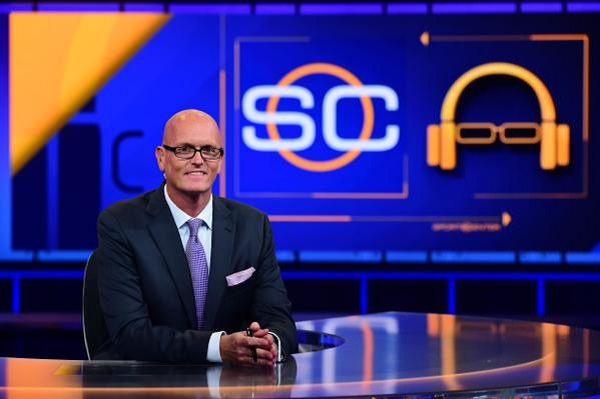ESPN’s decision to revamp the midnight Sportscenter around Scott Van Pelt this fall is one of their boldest moves in some time, and it’s drawn substantial critical praise both overall and for specific segments. As John Ourand writes in Sports Business Journal, ratings have been about the same as they were for the previous midnight Sportscenter, though:
ESPN has put a lot of promotional muscle behind Van Pelt’s show, and nearly three months into its run, viewership has not been spectacular. Ratings and viewers are generally flat with the “SportsCenter” that was on-air a year ago.
Van Pelt averaged a 0.5 rating/659,000 viewers for 33 Tuesday-Friday shows from its Sept. 7 launch to Nov. 19. A year ago, 26 episodes of the midnight “SportsCenter” averaged a 0.5 rating/712,000 viewers.
On Mondays, which have a bigger lead-in thanks to the highly rated “Monday Night Football,” last year’s midnight show averaged a 2.4 rating/3.505 million viewers, compared to this year’s 2.4 rating/3.398 million viewers.
Interpretation of those numbers really depends on whether you have a glass half-full or a glass half-empty perspective. Pessimists would say the static ratings suggest ESPN didn’t need to do a big personality-focused overhaul and could have just stuck with the traditional Sportscenter, while optimists would say Van Pelt’s show is holding the traditional Sportscenter ratings three months in and has more room to improve. Which view is more accurate may partly depend on the age breakdown of those ratings, which isn’t included in Ourand’s piece.
The new show has made no secret of its attempt to target a younger audience, which is valuable to both ESPN and its advertisers. If it is finding success on that front, that may be more useful for ESPN than “static ratings” would convey. It’s also interesting that ESPN is pumping up the alternate ways this show is being consumed, from WatchESPN streaming to engagement with certain segments on social media, both of which would suggest it is doing well with younger crowds. Here’s what ESPN senior vice-president (Sportscenter and news) Rob King told Ourand on that front:
It’s still too early for ESPN to worry about the show’s ratings. ESPN is committed to it for the long haul. Still, ESPN executives are heartened by the show’s digital performance. King said streaming numbers through WatchESPN would add a single digital percentage to the show’s overall viewership.
“It’s important for us to look not only at TV ratings,” King said. “Yes, the ratings are flat. As we start looking at a broader definition of ratings, we will see a lift.” …
Like much of Van Pelt’s late-night competition — think Stephen Colbert, Jimmy Fallon, Jimmy Kimmel — the midnight “SportsCenter” is broken into segments that can easily be shared on social media.
Five weeks after the show’s launch, for example, Van Pelt had a segment where he spoke about former NBA player Lamar Odom, who was in the hospital. The segment went viral, picking up 8,000 retweets and 7,000 likes when ESPN’s “SportsCenter” account tweeted it out at 1:23 a.m. ET. That’s 7.2 times higher than the average engagement of tweets from that account, ESPN says.
“These kinds of segments are entertaining regardless of whether or not you are watching them in that live news cycle,” King said. “They are eminently sharable, and we wanted to make sure that we honored that. We’re doing Periscope sessions immediately after the show because we learned in the prior iteration of a midnight show that there was an active audience that wanted to check in and wanted to listen to another five to seven minutes of Scott talking about the show that just happened.”
The focus on shareable segments is fascinating, as that’s growing both within the sports world and without. The likes of John Oliver and Katie Nolan are bringing far more of an audience to their companies (HBO and Fox, respectively) than ratings alone would indicate, as many of their segments are picked up and shared on blogs, social media and more, and even more traditional late-night shows such as those of Fallon, Kimmel and Colbert are going that route too. Shareable segments can’t be your only source of attention and revenue, as traditional ratings and advertising are still crucial, but they can be a nice value-added piece, and one that may become more important in the near future.
It’s also interesting to see ESPN talking about the streaming numbers here, as that fits in with the idea that WatchESPN is going to become even more important for them (especially with a discussed integration into the main ESPN app). Add a streaming boost to a shareable boost, and there’s a case to be made that this is working fine for ESPN so far. (Of course, pessimists would say that’s all spin to draw attention away from the flat ratings.)
At the least, it seems clear that the new-look SportsCenter with Van Pelt is doing all right from the company’s perspective, and that they’re going to stay the course with it and perhaps push it even more from the Sportscenter norm. (King told Ourand “We’re still figuring it out. Yes, it’s different. And, yes, you have permission to go further.” Van Pelt has also been positive about the show so far in interviews with GQ and SI.) We’ll see if this approach pays dividends for them in the long term.








Comments are closed.